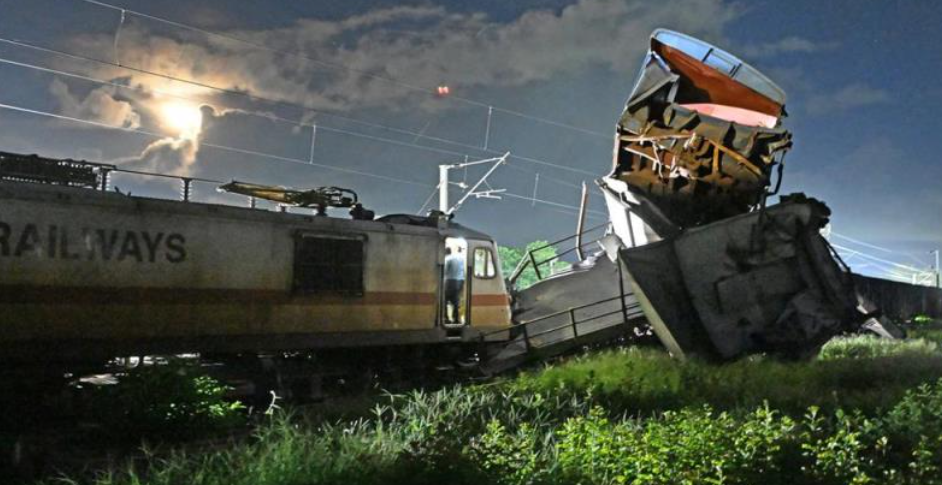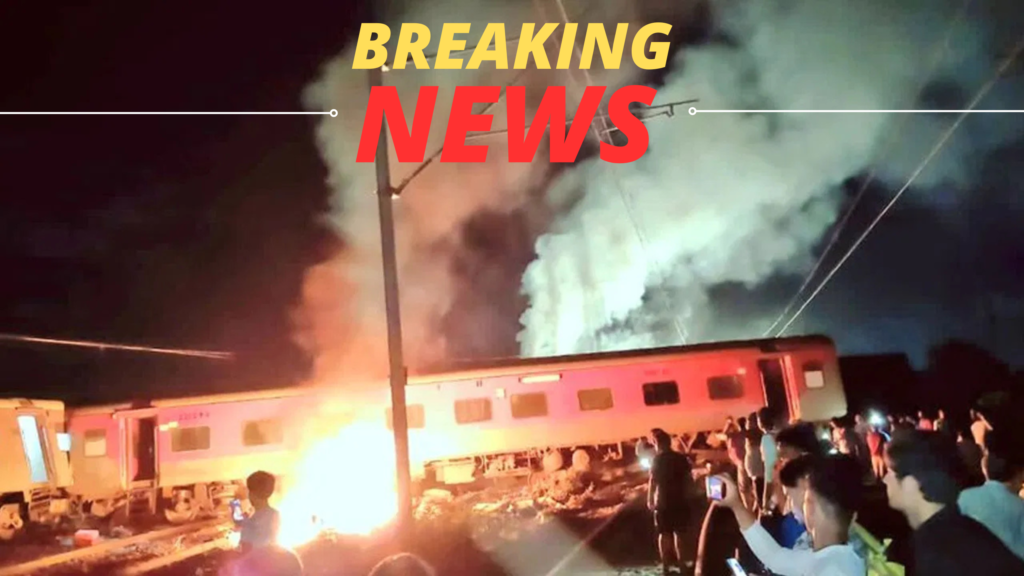
South eastern Train Accident – 12 October 2024
South eastern Train Accident On a typical Friday evening, the tranquility of South eastern Train Accident Kavarapettai railway station near South eastern Train Accident Chennai was shattered when the Mysuru-Darbanga Bagmati Express collided with a stationary goods train. This catastrophic event, occurring around 8:30 p.m. has sent shockwaves through the nation and prompted urgent inquiries into the causes and implications of this accident South eastern Train Accident. As investigations unfold and rescue operations continue, the incident raises significant concerns about railway safety, management, and accountability.
The Incident: What Happened?
The Mysuru-Darbanga Express was en route to its destination when it unexpectedly veered into the loop line and collided with a stationary goods train. Initial investigations have pointed towards human South eastern Train Accident error as a potential cause. R.N. Singh, the General Manager of Southern Railway, emphasized that all signals were properly displayed, and the express train had precedence on the main line. Yet, despite these precautions, the train erroneously entered the loop line, resulting in a catastrophic collision.
Witness accounts and preliminary reports indicate that the accident was sudden and violent, derailing 12 coaches of the passenger train. Images and drone footage from the scene depict a chaotic aftermath, with damaged coaches strewn across the tracks and a crowd of onlookers gathered at the site, some in shock and others recording the harrowing event.
South eastern Train Accident Emergency Response and Rescue Operations
In the wake of the collision, Tamil Nadu’s Chief Minister, South eastern Train Accident M.K. Stalin, took immediate action by monitoring the situation closely. He dispatched South eastern Train Accident Deputy Chief Minister Udhayanidhi Stalin, along with other government officials, to the scene to oversee rescue operations and ensure the well-being of the passengers. The deputy chief minister confirmed that 22 ambulances were dispatched promptly to the site, and three injured individuals were transported to Stanley Hospital for treatment.
Udhayanidhi Stalin’s visit to the hospital highlighted the government’s commitment to the victims. He reassured the public that more beds were being arranged for any additional injured patients, signaling an organized and rapid response to the unfolding crisis. His words emphasized the gravity of the situation, as he stated, “There have been no casualties reported so far,” offering a glimmer of hope amidst the chaos.
A Community Rallying Together
Local authorities quickly mobilized resources to assist affected passengers in South Eastern Train Accident. Nearby marriage halls were opened to provide temporary accommodation, while South eastern Train Accident food and water were distributed to those stranded by the accident. The swift actions of both governmental and community organizations showcased a commendable level of preparedness and compassion in a time of crisis.
Political Reactions and Accountability
As news of the South eastern Train Accident spread, political leaders began to weigh in. Rahul Gandhi, the leader of the Opposition in the Lok Sabha, criticized the central government, drawing parallels to the tragic Balasore accident that had occurred earlier. He expressed frustration over the government’s apparent failure to learn from previous incidents, South eastern Train Accident asserting that accountability must begin at the top. “How many more families must be destroyed before this government wakes up?” he questioned, echoing the sentiments of many who are fed up with the recurring theme of railway accidents in India.
Gandhi’s remarks underscore a critical issue facing the Indian railway system: the need for enhanced safety measures and more stringent oversight to prevent such accidents from happening in the future. His call for accountability resonates with a public that is increasingly concerned about the safety of train travel, a lifeline for millions across the country.
The Broader Context: Railway Safety in India
South eastern Train Accident it falls within a troubling pattern of railway accidents in India. The country’s railway system is one of the largest in the world, carrying millions of passengers daily. Yet, with such a vast operation comes significant challenges regarding safety and infrastructure maintenance. The Balasore accident, which resulted in nearly 300 fatalities, is a haunting reminder of the potential consequences of neglecting safety protocols.
South eastern Train Accident The recurring nature of these incidents raises questions about the adequacy of safety measures in place. The Ministry of Railways has been under pressure to invest South eastern Train Accident in modernizing infrastructure and implementing better training programs for staff to mitigate human error—a leading factor in many accidents.
The Role of Technology in Improving Safety
South eastern Train Accident As investigations into the Kavarapettai collision continue, it is crucial to consider how technology can play a pivotal role in enhancing railway safety. Automatic Train Protection (ATP) systems, for example, can help prevent collisions by automatically applying brakes if a train approaches a signal at danger. Furthermore, the implementation of advanced signaling systems can provide real-time updates to train operators, reducing the South eastern Train Accident risk of human error.
South eastern Train Accident Investments in these technologies could be vital South eastern Train Accident for restoring public confidence in the safety of Indian Railways. With the rapid pace of technological advancement, the government must prioritize these solutions to safeguard the South Eastern Train Accident.

Impact on Train Services
The South eastern Train Accident saw significant disruptions in train services across the region. With the Mysuru-Darbanga Bagmati Express accident affecting the Chennai-Gudur section, two trains were canceled, and several others were diverted, causing inconvenience for countless travelers. The railway authorities established help desks at major stations, such as Chennai Central, to assist affected passengers and provide them with necessary information and support.
Restoration work was initiated promptly, with teams working tirelessly to clear the wreckage and resume normal operations. The scale of the task was evident, with damaged coaches requiring extensive repairs and safety checks before any service could resume.
Looking Ahead: Preventive Measures and the Path Forward
South eastern Train Accident In light of this incident, it is imperative that the Indian government and railway authorities take a proactive stance in addressing the systemic issues plaguing the railway network. Comprehensive reviews of safety protocols, regular training sessions for railway personnel, and substantial investments in infrastructure upgrades are essential steps in preventing future accidents.
Moreover, a transparent investigation into the Kavarapettai collision is necessary to identify specific lapses that contributed to this tragic event. Ensuring that lessons are learned from this incident—and that appropriate measures are taken to implement those lessons—will be crucial in restoring public trust in the railway system.
Conclusion: A Call for Change
South eastern Train Accident The Mysuru-Darbanga Express collision at Kavarapettai South eastern Train Accident is a stark reminder of the vulnerabilities inherent in a system that is a lifeline for millions. While the immediate response from government officials and emergency services was commendable, it is the long-term changes in safety practices, accountability, and infrastructure that will ultimately define the future of railway travel in India.
South eastern Train Accident As the investigation unfolds and the community begins to heal, there is a collective hope that this incident will not be in vain. A renewed commitment to safety, transparency, and accountability is essential to ensure that tragedies like this do not recur. The lives of countless passengers depend on it.
FAQ’s
General Questions
- What was the South Eastern train accident?
- The South Eastern train accident refers to a collision or derailment involving a train operated by the South Eastern Railway.
- When did the accident occur?
- The specific date of the accident can vary; please refer to news reports for the exact timing of a particular incident.
- Where did the accident take place?
- The location can differ for each incident; details can be found in news articles covering the event.
- How many trains were involved in the accident?
- Usually, it involves one train, but there may be other trains affected depending on the circumstances.
- What caused the accident?
- Causes can vary, including human error, signal failure, or equipment malfunction. Investigations typically determine the specifics.
Casualties and Injuries
- Were there any casualties?
- The number of casualties can vary; initial reports usually provide estimates that may change as more information becomes available.
- How many people were injured?
- Injury counts are often updated as rescue operations progress and hospitals report admissions.
- What types of injuries were reported?
- Common injuries include fractures, concussions, and other trauma-related issues.
Emergency Response
- What was the emergency response to the accident?
- Emergency services, including ambulances and fire services, are dispatched to the scene to assist injured passengers.
- How many ambulances were sent to the site?
- The number can vary; official statements usually provide this information shortly after the incident.
- Which hospitals received the injured?
- Local hospitals typically manage the influx of patients, with specific hospitals announced in official reports.
Investigations
- Who is investigating the accident?
- Investigations are usually conducted by railway safety authorities and sometimes include government oversight.
- What are the main focuses of the investigation?
- Key focuses often include determining the cause, assessing safety protocols, and identifying any lapses in procedures.
- How long does the investigation usually take?
- Investigations can take weeks or even months, depending on the complexity of the incident.
Public Reaction
- What was the public’s reaction to the accident?
- Public reactions often include shock, anger, and calls for better safety measures.
- Did any political leaders comment on the incident?
- Yes, political leaders typically issue statements expressing condolences and calling for accountability.
Safety Measures
- What safety measures are in place to prevent such accidents?
- Safety measures include signal systems, regular maintenance checks, and staff training.
- Have there been previous accidents involving South Eastern trains?
- Yes, like many rail networks, South Eastern Railway has experienced past accidents, each prompting safety reviews.
- What improvements are being proposed to prevent future accidents?
- Proposals may include upgrading signaling systems, enhancing staff training, and increasing investment in infrastructure.
Aftermath and Support
- What support is available for victims and families?
- Victims and families often receive support from local authorities, charities, and sometimes government compensation.
- How can affected passengers seek assistance?
- Affected passengers can usually contact railway customer service or dedicated help desks set up post-accident.
Media Coverage
- How is the accident covered in the media?
- Media coverage typically includes reports on the incident, eyewitness accounts, and updates on the investigation and recovery efforts.
- Are there any online resources for updates?
- Official railway websites, news outlets, and social media platforms often provide real-time updates.
Future Considerations
- What role do safety audits play in rail operations?
- Safety audits are crucial for identifying risks and ensuring compliance with safety regulations.
- How can passengers contribute to safety on trains?
- Passengers can report unsafe conditions and follow safety guidelines while traveling.
- Are there any upcoming regulations or policies being considered?
- Regulatory bodies may consider new policies based on investigation findings, but specific proposals would need to be confirmed through official channels.
Broader Context
- How does this accident affect rail travel in India?
- Such accidents often lead to increased scrutiny of railway safety practices, affecting public confidence in rail travel.
- What is the historical context of train safety in India?
- India has a mixed history of rail safety, with significant improvements made but also recurrent issues that highlight the need for ongoing reforms.
Conclusion
- What should passengers keep in mind while traveling by train?
- Passengers should stay alert, follow safety instructions, and be aware of emergency procedures.
- How can we advocate for better railway safety?
- Advocacy can involve engaging with local representatives, participating in safety awareness campaigns, and supporting proposed safety legislation.

Homepage:- Click Here
- Train Accident in the Southeast The quiet of South Eastern Train Accident Kavarapettai railway station, which is close to South Eastern Train Accident Chennai, was disturbed on a normal Friday night when the Mysuru-Darbanga Bagmati Express struck a stationary goods train.
- shocked the country and sparked immediate investigations into the causes and effects of the South Eastern Train Accident. The incident raises serious questions about railway safety, management, and accountability as investigations and rescue operations proceed.


